More Foodie Tales from Sicily
Part 1: A Palermo market tour--or snacking (deliciously!) on history and street food (and even trying a spleen sandwich!)

Hello and welcome to new subscribers! So excited that you’re here! Though I try not to pay attention to numbers, I received a notification yesterday from Substack, the platform where I publish this newsletter, that my subscriber list finally passed the 1,000 mark! Woo-hoo! It was just the pat on the back I needed. Writing can be a bit of a lonely business—you always wonder if anyone will be there when you press the publish button. So thanks a million (or maybe I should I say, a thousand!) for the vote of confidence!
And now, as promised, here’s more from our too short but memorable visit to Sicily. If you missed my last two posts about the island, you can find them here and here.
“A lot of Americans go to Rome and Florence and other parts of Italy, but not to Sicily,” my husband Jeff says to our guide Laura Prestigiacomo at the end of a 3-hour food tour through two lively Palermo markets on our first full day on the island. “What are they missing?”
“They are missing everything,” Laura says, “because Sicily is like the key to discover Italy. In Sicily you can do everything. You can see beautiful temples and then you can see beautiful cities with amazing churches. You can hike, you can visit the markets. It’s not such a small island.”


We discovered just how big this task of “seeing Sicily” was on our two-week trip, which took us from Palermo, the capital of both the autonomous region of Sicily (there are actually five such regions in Italy) and of the surrounding metropolitan province, to Syracuse (Siracusa), a 2,700-year-old city rich in Greek and Roman history and birthplace and home of the famous mathematician Archimedes, to beautiful Taormina, famed as a vacation resort long before The White Lotus added fuel to the fire, and, like the rest of the island, steeped in ancient history.

Though you can’t see it all, you can certainly try—and along the way get caught up in the spell of the place—the mix of ancient and modern culture on an island in the middle of the Mediterranean that has been conquered enumerable times and is layered with the evidence, architecture, culture, style, language and gastronomic influences of its succession of Greek, Roman, Byzantine, Arab, Norman, French and Spanish rulers.

“I love Sicily because it’s like the bridge between Africa and Europe,” Laura tells us. “I think that inside of us, we have all of these cultures.”

Nowhere was this “bridge” more apparent than on our food tour, which also turned out to be a great introduction not only to Palermo but to the street foods that reflect its varied ethnic heritages and history. Our guide Laura was a real find (as you will see from the clips Jeff includes of her in his video!). A native of Palermo (they’re called Palermitani), she was knowledgeable, passionate and opinionated about her subject. (FYI: This tour and others can be found at Steaty.com.)
“The markets to me are like the essence of the city,” she told our small group of six, waving us on. “Amuni!” she said. That’s “Let’s go” in the local Palermo dialect of Sicilian (Sicilianu), which is recognized as a minority language by UNESCO.
Fast food, Palermo style (and an opera house)
We started at the Capo Market, not far from the magnificent Teatro Massimo, the largest opera house in Italy, which we toured the next day. Renowned for its acoustics and its neoclassical architecture and late Renaissance-style interior, it’s awe-inspiring, even if you don’t manage to see an opera there—we didn’t, but caught a few strains of the orchestra rehearsing for a performance of Richard Wagner’s Tristan und Isolde (sublime!).

At the Capo Market, the most centrally located of the three we visited (two with Laura), we tasted some typical street fare—most of it fried and deliciously hot, some of it slightly X-rated, like the little potato croquettes called cazzilli in Sicilian, meaning, Laura told us with a smile, “little penis, because that’s what it looks like.”
It was only about 10:30 in the morning, but the cazzilli (also called crocchè—croquettes), made of mashed potatoes, salt, pepper and a surprising addition of dried mint, paired well with a local beer called Forst. We also tried panelle, Sicilian chickpea fritters, formed from chickpea meal cooked into a paste like polenta, cut into slender squares, fried, then often served inside bread or a sesame bun, sometimes with cazzilli too (fried carb with fried carb—my kind of snack!), and a slice of lemon.
Laura explained that these are simple foods, which like cazilli and arancine (called arancini in Catania on the other side of the island), the breaded, filled and fried rice balls that are also so popular here, “were invented by Arabs.”

Arancina(o), an Arab legacy
Like most food histories, the story behind the arancino (or arancina in Palermo because its shape like a round arancia—or orange—earns it a feminine ending, arancine when plural) isn’t so simple. Most sources seem to agree its roots go back to the period from the 9th to the 11th centuries when Sicily was under Arab rule, sometimes referred to as the Saracen era. Three dynasties ruled the island, making Palermo—which was then called Bal’harm—into a thriving capital city1 filled with narrow winding streets, souks (Arab markets that are the forerunners of the markets that we visited), and many remnants of architecture with distinctive Arabic details that still survive and come as a surprise as you wander through the streets.
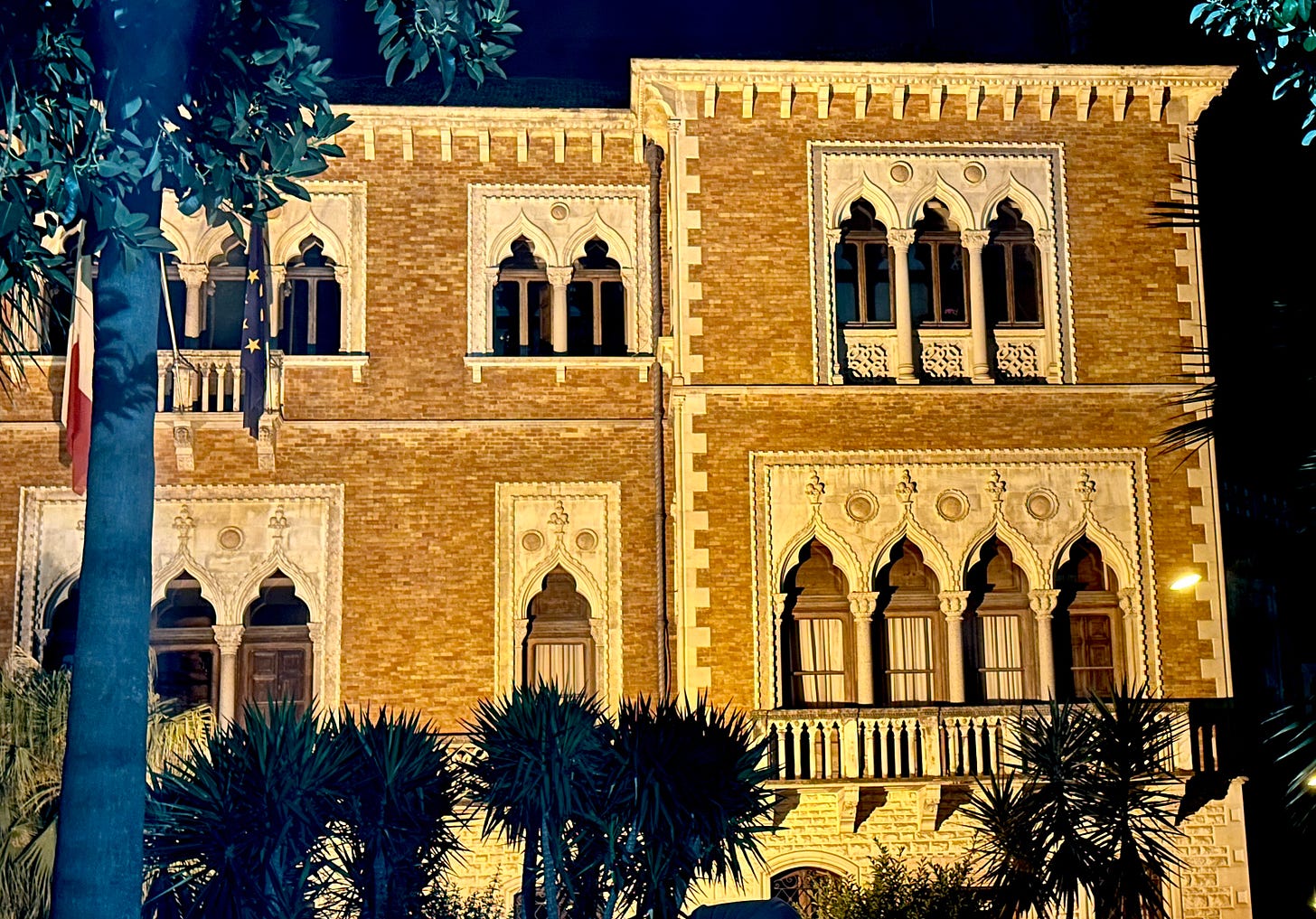
Not only did the Arabs influence architectural styles, but also many of the signature foods of the island and irrigation techniques that helped them flourish— including not only the rice used in arancine but also sugar cane, cotton, oranges, lemons and apricots; spices such as saffron, cinnamon, cloves and mint; seeds and nuts, including sesame, pistachios and almonds; and techniques for making the candied fruit and nuts and traditional Sicilian marzipan fruits (frutta martorana) that you can find throughout Sicily.2
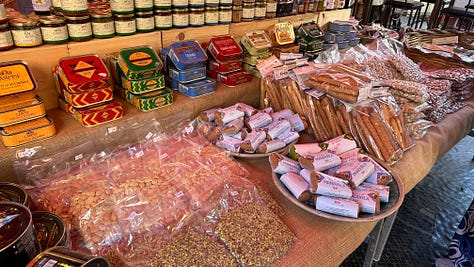
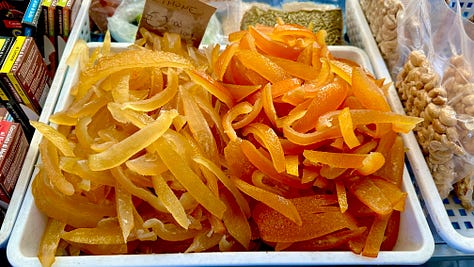
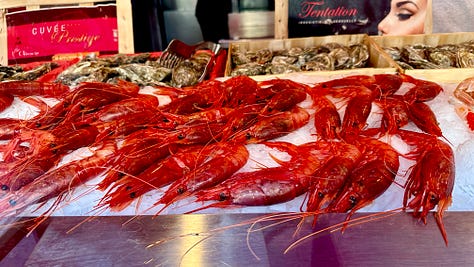
All of these goods are evident in abundance at the markets and in the dishes and desserts that catch your attention and define the culinary scene—including the very popular cannoli, a Sicilian invention that so many of us have tasted in places where Sicilian immigrants settled in the U.S. (like our favorite, San Francisco’s North Beach!)

As for those little balls of arancina goodness, they probably began as an Arab dish of risotto with veal and vegetables. Later iterations (probably from the Normans) made the meal portable, turning it into a saffron-flavored rice ball with the topping tucked inside, then covering it in breadcrumbs and deep-frying it.

These days you can find many varieties (40 in all!) of arancine at Ke Palle, a hot spot on Palermo’s bustling Via Maqueda. That includes two of the most traditional types: meat and vegetable, and prosciutto and cheese; fishy fillings like swordfish, eggplant and mint, and smoked salmon and squid ink. There are even two sweet flavors, Nutella and pistachio. I tried Ke Palle’s Norma—eggplant, tomato and ricotta salata (a pressed, salted, aged ricotta that is firmer than fresh ricotta)—but my favorite was a spinach and cheese arancina I purchased from a little stand near the Ballarò Market. I can still remember the satisfying crunch as I bit into it.
On the Streaty.com website is a recipe for arancina with carrot, onion and veal that you can find here. Laura also shared an arancina recipe from a friend that I hope to post in the future after I give it a try!
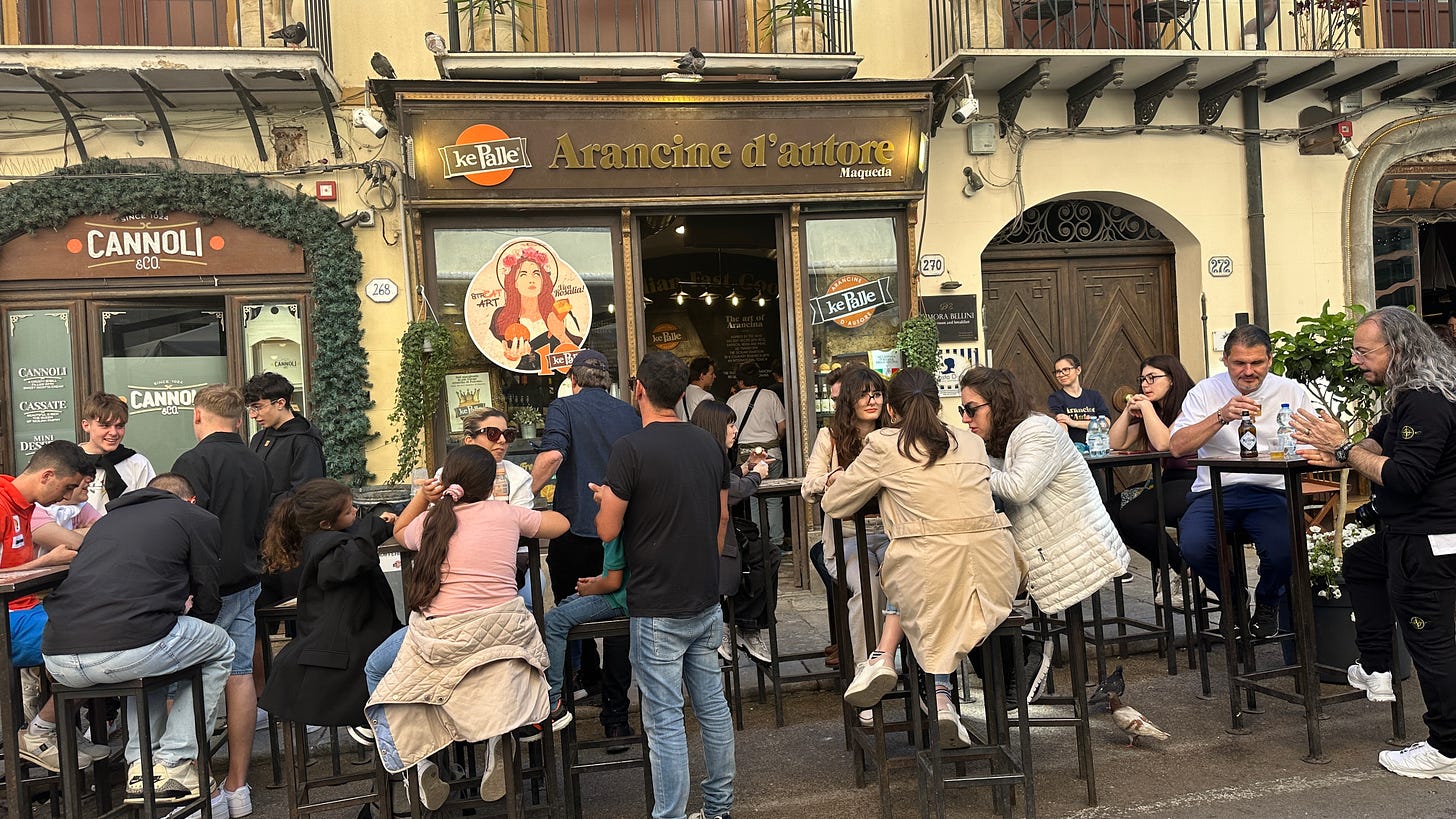
Spleen sandwich, anyone?
Still hungry? There’s more!
We continued eating our way through the city, sampling little morsels of spring onions wrapped in bits of pork rib, called Mangia e Bevi (literally “eat and drink” in Italian), accompanied by a Sicilian beer called Semedorato. Snacks like these are common when young people go out drinking with their friends and have a special picnic where “you eat a lot of meat,” Laura said. “In Palermo,” she added, “it’s hard to be a vegan.”
This turns out to be oh so true, especially when she presents us with the next taste challenge.
“Who’s up for a spleen sandwich?”
The dish is called pane con la milza or pani câ mèusa in Sicilian.
“It’s our most popular food, along with aranchina,” Laura said.
Three of us are game to try some. The vendor fishes slices of meat that look like skinny brown pieces of roast beef from a big metal pot and slaps them inside a round sesame bun.
I gulp and take a bite. It really doesn’t taste bad—chewy, meaty, tangy when I squeeze lemon on it. I could almost imagine the meat was pastrami, except that I know it comes from the innards of a baby cow (veal)—specifically the animal’s spleen and lungs, and sometimes the trachea, boiled, then fried in lard. Given the lard—melted pork fat—I was astonished to read the dish might have Jewish origins. How could that be?
According to Italia.it, pani câ mèusa dates back to the Middle Ages when there were Jews living in Palermo working as butchers.
“Since their religious beliefs did not allow them to generate a profit from slaughtering animals, instead of money they received offal as a reward. These included the spleen, lung and trachea, which they began to season in lard and consume as filling for their sandwiches.”
As a Jew, I must admit the latter part of the story makes no sense to me because I imagine that Jews then might have followed the laws of keeping kosher and not eaten pork products, especially if they were following other “religious beliefs,” as the website says. But perhaps, people then, as now, were selective in the laws they chose to follow.
La Vucciria
As we wander into La Vucciria, another ancient Palermo market whose origins go back to the 12th century, Laura tells us the name comes from the French word for a butcher’s shop, boucherie, but that the word vucciria actually means “loud” or “noisy.”
When we visit, the market is pretty quiet, though we hear that there’s quite a bit of action at night, especially at Taverna Azzura, which, according to one blogger I read has a split personality, turning into a wild place for dancing and drinking when the sun goes down.
We didn’t see any of that on our midday ramble, just sitting down peacefully at the bar for a sample of sfincione, described as a Sicilian pizza, but thicker, more like a focaccia topped with anchovies, cheese, tomatoes, onions and oregano (here’s a recipe I found). Of course there was something alcoholic to drink too—this time it was a sweet sipping wine called Sangue, meaning “blood” in Italian, a local wine that tastes a bit like Marsala and nothing like blood.

That’s all from me, folks.
Please keep an eye on this space for Part 2—our trip to Syracuse (Siracusa) and the beautiful island of Ortygia, plus that day on a farm (called an agriturismo) that I promised.
Meanwhile, for the overview, with incredible visuals, tips and laughs, check out Jeff’s PhotowalksTV episode below. I think it’s one of his best.
Thanks to all of you for your likes, shares, comments and subscriptions (still free!). I appreciate every last one of you!
Ciao!
Ruth
L. Mendola and V. Salerno, “Sicilian People: The Arabs,” Best of Sicily Magazine, 2005. I found a lot of very interesting information here and elsewhere on the website—plus some tour possibilities.
One good source I discovered on the history and variety of Sicilian cuisine was a University of Massachusetts Amherst Journalism Department five-part series on Sicilian food written by Tom Musco. Here are the links: “Sicilian Food,” “A History of Sicilian Cuisine,” “Sicilian Food Today,” “The Sicilian Pantry,” and “Typical Sicilian Dishes.” It definitely made me wish I had tried more dishes!







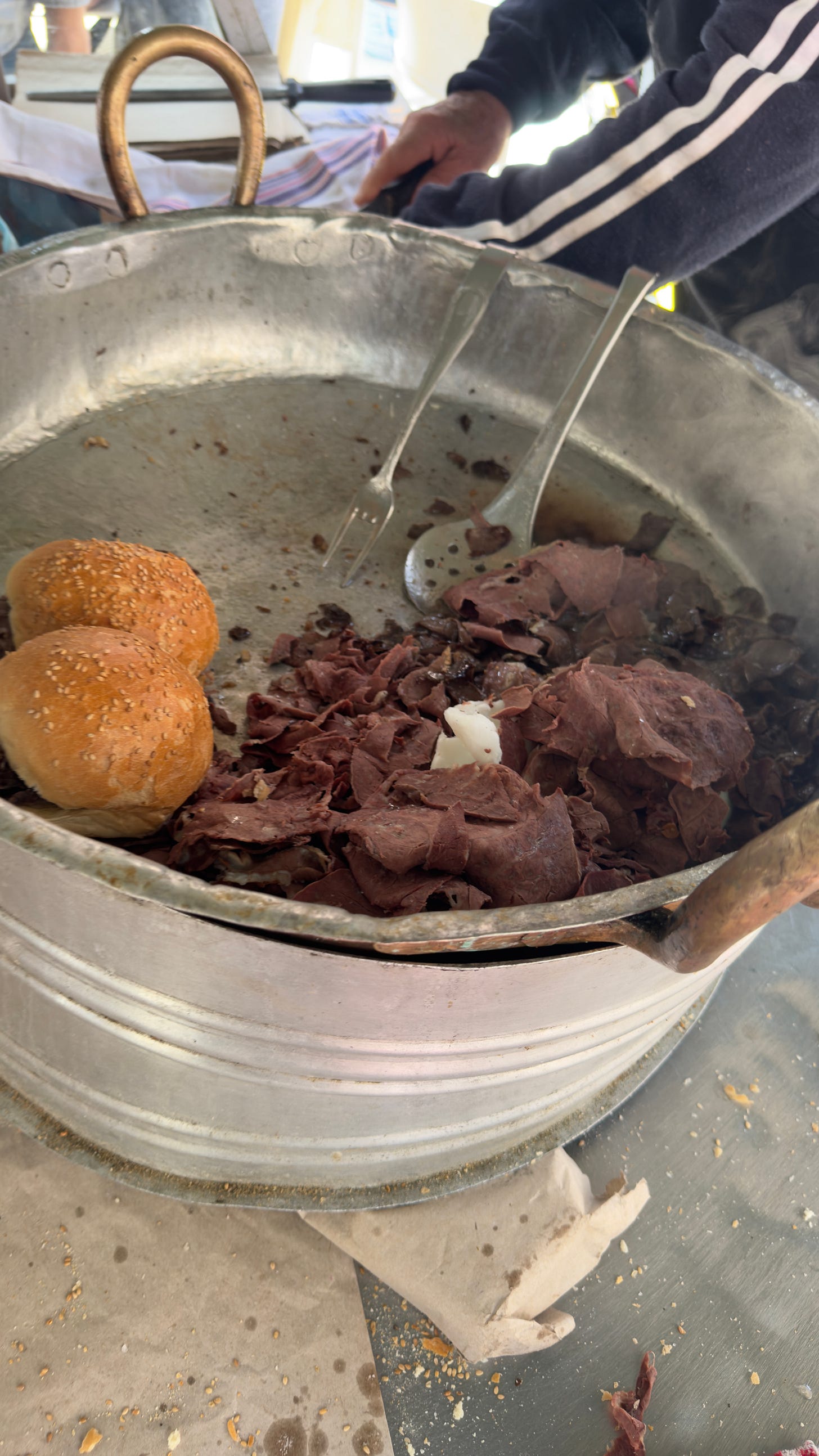

Congratulations Ruth!! 🎊 👏 💐 🥳 onwards and upwards!
Congrats on the subscribers. Always look forward to your articles, and it seems others do too.